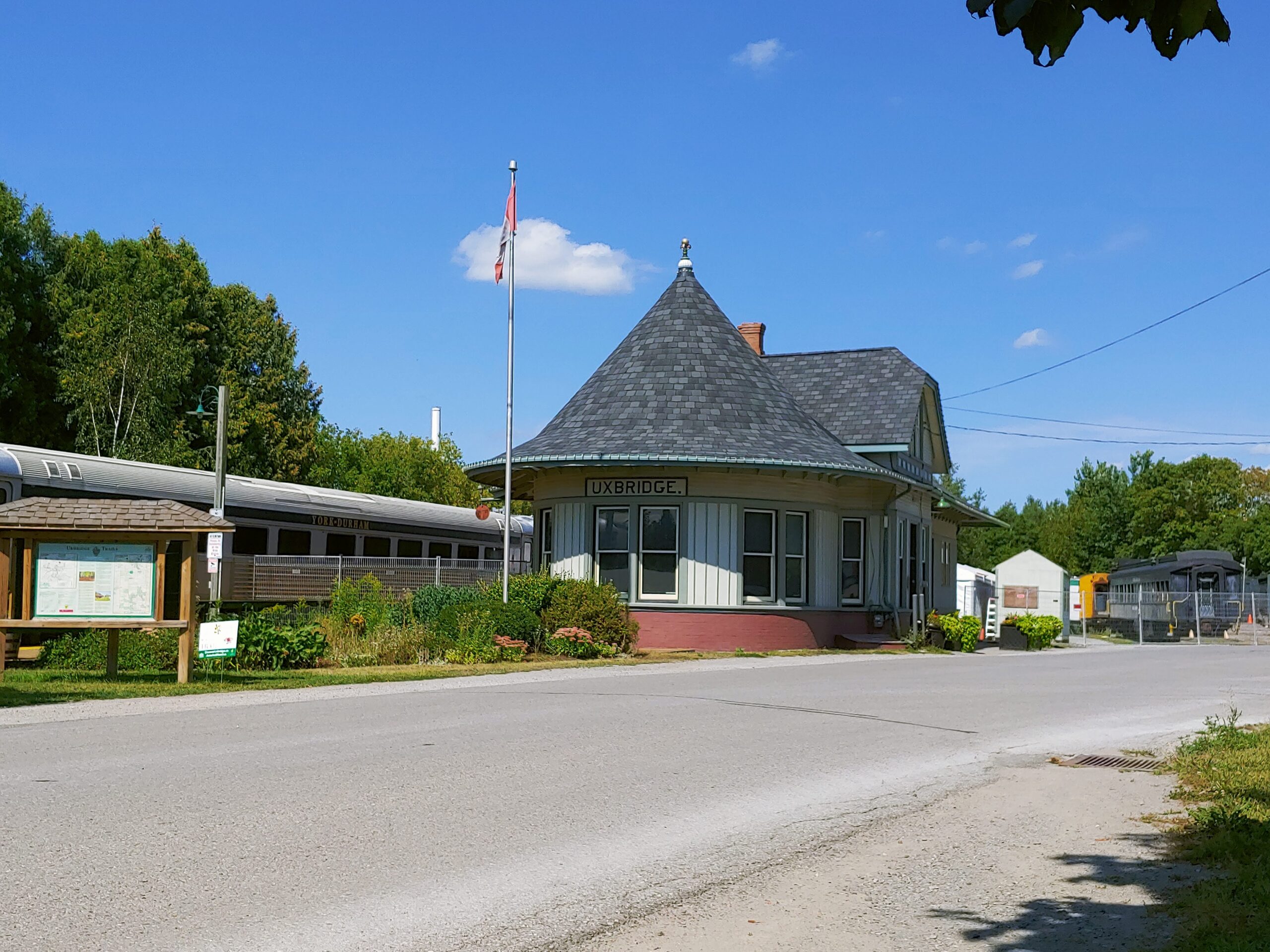From Train Service to Bar Service: Links to Ontario Railway History in Craft Beer (Part Four)
I hope you have enjoyed this series so far. The fourth and final part of this research blog series outlines specific examples of beers that reference Ontario railway history through their name or label art. This list has the most examples, and the more time I spend looking, the more I find. (not that I have a problem with that!)
Ready for last call? Let’s finish strong!
Smoke Stack Stout, Lindsay Brewing Company, Lindsay, ON
Located in my hometown of Lindsay, ON, Lindsay Brewing Company is one part of the “Pied Eyed Monk”, a brewery, taproom, and restaurant located in the historic C.L. Baker building. “Smoke Stack Stout” is one of their six main beers.
The label on this beer is adorned with a drawing of Toronto, Hamilton, & Buffalo 0-6-0 yard switcher #42 and a CNR wood sheathed caboose. Both of which sit on display in Memorial Park alongside a CNR SW-8 and other rail cars. The description on the label makes reference to the year 1857, the year the railway first arrived in Lindsay. It also mentions Victoria Junction, which connected the Victoria Railway to the Port Hope, Lindsay, & Beaverton Railway.
Lindsay steadily grew as a railway town in the 19th/early 20th centuries with the arrival of the Whitby, Port Perry, & Lindsay Railway in 1877, the Lindsay, Bobcaygeon, & Pontypool in 1904, and the Georgian Bay & Seaboard in 1912 (both of which later acquired by the Canadian Pacific Railway). The Midland Railway of Canada chose Lindsay as the location of their engine sheds and repair shops shortly after acquiring the PHL&B, Victoria, and WPP&L routes in 1881. A large portion of the trains passing through town were grain trains running between the elevators at Midland and the CNR mainline at Belleville. This continued until 1959 with the opening of the St Lawrence Seaway. From this point on traffic gradually declined in Lindsay, further enhanced by the cessation of passenger trains in 1962 and the cancelation of Lindsay’s terminal status in 1978. Local freights continued to make infrequent appearances until the last rails were abandoned and removed in October 1992 (Hansen p. 75).
With so few examples of railway heritage remaining in Lindsay, this historical nod is a great acknowledgement of the railway’s importance to the growth and economy of the town. I found this beer to be very smooth with notes of chocolate and almost no bitterness. Very enjoyable!
For more information about Lindsay Brewing Company please click here
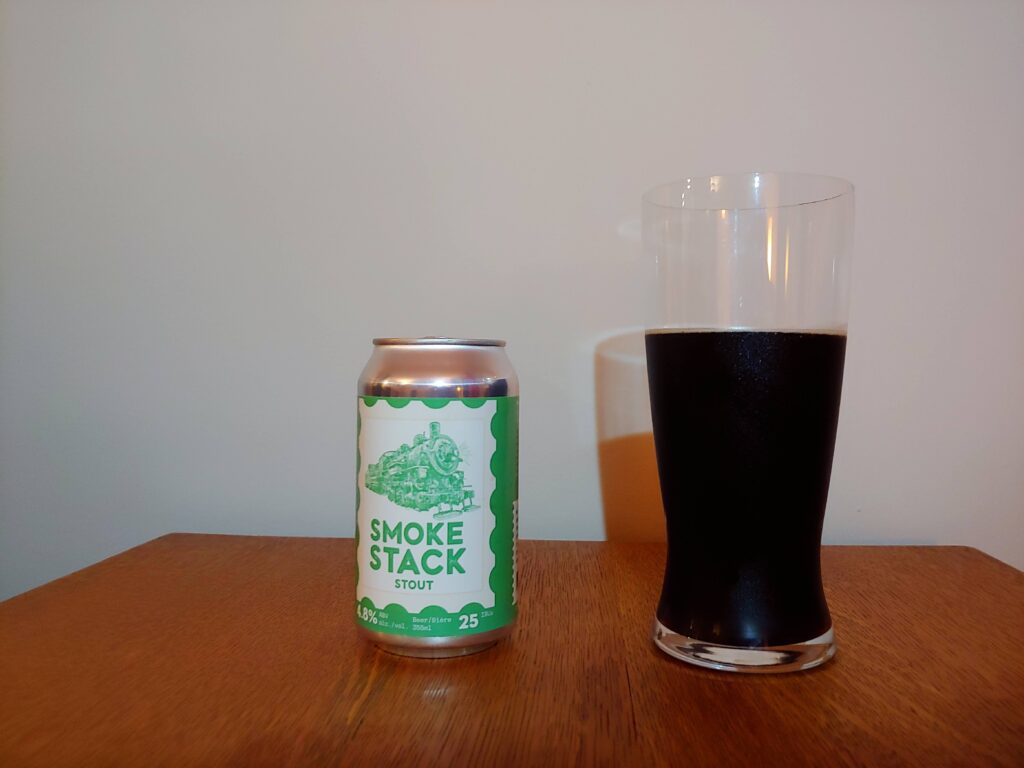
IB&O Pale Ale, Devil’s Edge Brewery, Irondale, ON.
One has to take a trip off the beaten path to discover this brewery and the railway associated with one of its beers. Devil’s Edge is located in the hamlet of Irondale on highway 503 between Kinmount and Gooderham. A small microbrewery, they have a small variety of beers. One of which is the “IB&O Pale Ale”. This auburn coloured beer has a subtle balanced flavour making it great for slow sipping with a nice meal.
Irondale was also a namesake stop of the Irondale Subdivision. It was originally chartered by the Irondale, Bancroft, and Ottawa Railway in 1884. Incorporating part of a crude 1880 mining route, Its purpose was to shuttle iron ore from the mines to the nearby Victoria Railway (later CNR Haliburton Subdivision). The IB&O opened between Howland Junction (north of Kinmount) to Irondale in 1886-87. Overtime as infrastructure improved and railways expanded further inland, it was decided to expand the route eastward. After years of delays, it was completed as a northern connection route between Howland Junction and York River, linking the Haliburton and Maynooth Subdivisions.
The line’s rural location ended up being its downfall. Over time the iron ore resources depleted and no communities of any significance sprung up along the line. The line was also notorious for having one of the steepest grades in Ontario, a 3.64% grade located near Baptiste (Hansen, p. 274, Heels, p.43). The Irondale Subdivision was the most direct rail link between Lindsay and Bancroft, which allowed it to persevere for many decades through mixed train service. It became redundant when local highways were improved and the line was abandoned and removed in 1960.
Not much is known about this brewery. There is no known website or social media presence. They do appear on the “Untappd” beer app where craft beer lovers can rate the beers they tried. I was fortunate to receive a bottle from my father a couple of years ago at Christmas. A picture of this beer appears below.
To learn more about the beer at Devils Edge Brewery please click here

Swing Bridge Blonde Ale, Manitoulin Brewing Company, Little Current, ON
One of two breweries located on Manitoulin Island, Manitoulin Brewing Company has a wide variety of beers to suit one’s palate. One beer of note is the “Swing Bridge Blonde Ale”. This smooth and easy drinking beer is named for the swing bridge that connects the island with the mainland at the north east end of the island. The bridge itself appears on the can.
This bridge was built by the Algoma Eastern Railway in 1913 (Wilson, p. 213) in order to allow trains to access the island via the Little Current Subdivision. The rails later became under the ownership of the Canadian Pacific Railway, who upgraded the bridge to the version present today. In later years the deck was planked in to allow both cars and trains to use the bridge to access Manitoulin Island. While examples of these dual purpose bridges exist across North America, this is one of only a few located within Ontario. Passenger service ended in the sixties, with freight service continuing for another two decades before the rails were abandoned.
This bridge remains standing today carrying Highway 6 across the channel. It continues to serve as the northern access point to the island, with the only other option being the Chi-Cheemaun ferry at the south end. It still swings to allow boat traffic to pass below. In more recent years, there have been plans to retire the aging structure and replace it with a newer larger overpass.
For more information about Manitoulin Brewing Company please click here

Iron Horse Trail IPA, Stockyards Brewing, Kitchener, ON
Known formerly as Red Circle Brewing Company, Stockyards Brewing pays homage to local history through their location in a former factory and the names of their many beers. One beer of note is “Iron Horse Trail”. This beer is named after the walking path of the same name which passes the brewery on the west side. This pathway acts as a useful corridor that allows walkers and cyclists to travel from Waterloo to South Kitchener.
The pathway in question is a former railway line operated by the Grand River Railway, which was later acquired by the Canadian Pacific Railway. A unique feature of this railway was that electric powered locomotives plied the line using power from overhead wires. The stretch occupied by the Iron Horse Trail is part of the northern segment that ran from Cambridge to what is now Uptown Waterloo. It also extended south to Port Dover as part of the Lake Erie & Northern Railway. Passenger trains were terminated in 1955 and replaced by busses.
Freight service continued on the line after 1955, and trains were typically operated by SW1200RS locomotives. This continued until 1993 when the rails were abandoned and removed. Another connection to beer and distilled spirits is present in two former customers at the north end of the line in Waterloo. The Kuntz Brewery (later owned by Carling and Labatt) on King Street South and Seagrams on the corner of Erb and Caroline Streets were serviced by the GRR and later CPR until the closure of the line in 1993. The GRR/CPR interchange yard with the CNR’s Waterloo Spur stood across the street from Seagrams in the area near where The Barrel Yard rental suites and Waterloo Memorial Recreation Centre stand today.
Iron Horse Trail is an American IPA. It pours a pale yellow colour with a slight haze. It has notes of citrus with a lesser hoppy kick then other IPAs. With a stronger ABV and IBU level at 6.3% and 60 respectively, it serves well as a meal beer or slow sipper. This is personally one of my favourite Ontario craft IPAs.
For more information about Stockyards Brewing/Stockyards Beverage Company, please click here
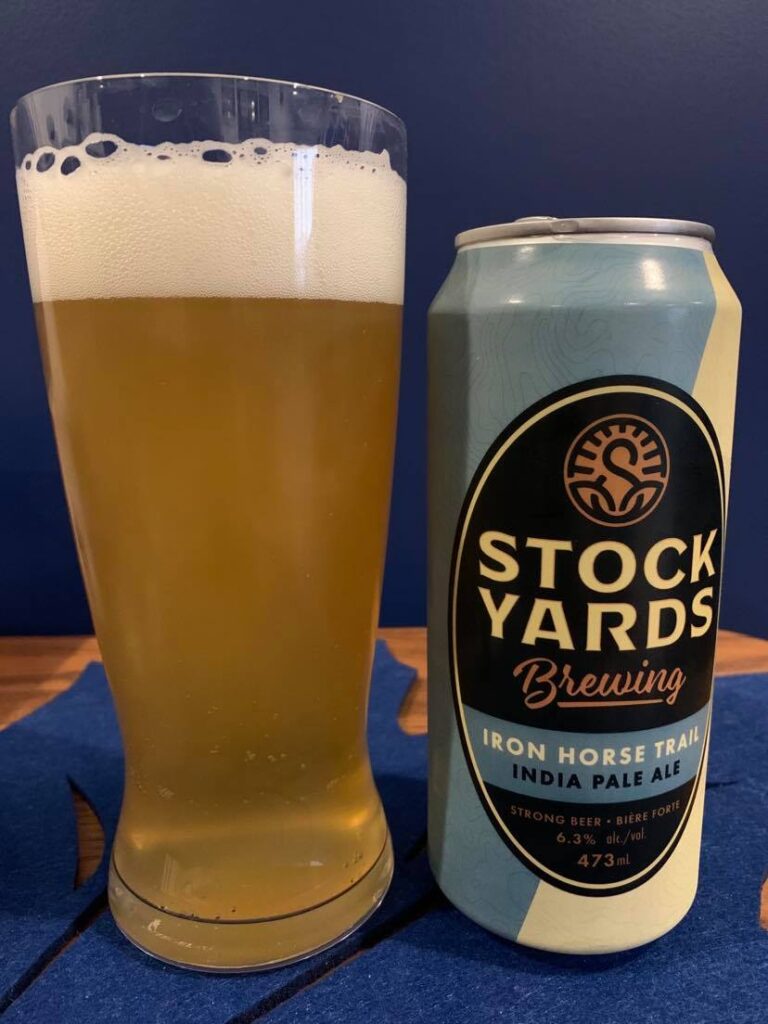
Hog Head LP&S, Caps Off Brewing Company, St Thomas, ON
Hog Head LP&S is brewed by Caps Off Brewing Company, a microbrewery located in downtown St Thomas. This beer is a low IBU American Style Lager with an above average 6% ABV. One of the ingredients of this beer is hops found alongside the London & Port Stanley Railway, which is referenced in the name by including the railway’s initials (L&PS).
The London & Port Stanley Railway began operations in 1856 using steam powered locomotives. In 1913 these steam locomotives were replaced by electric power units. The direct service provided by this railway between London and Port Stanley made it popular with tourists looking to escape the city and relax at the many lakeside attractions at Port Stanley. St Thomas is located about halfway along the route, and a station was constructed just north of Talbot Street.
As roads improved and cars became more popular the route became redundant. Passenger service ended in 1957 with the route continuing on as freight only. When the CNR acquired the route in the 1960s, the electric locomotives of the L&PS were replaced by diesels. The section between St Thomas and London continues to be serviced by local CNR freights from London.
The southern leg from St Thomas to Port Stanley was abandoned in 1982 following a severe washout along the route. It sat dormant for many years before being acquired by Port Stanley Terminal Rail. After many years of restoration and hard work the route reopened for use as a tourist railway. While operations are mostly between Port Stanley and Union, the trains of the PSTR make the occasional excursion north to St Thomas to visit the restored PSTR station as well as the Michigan Central railwaylands where the Elgin County Railway Museum and MCR station stand today. The north and south legs of the line remain disconnected, however consideration has been given towards connecting the short gap between each section.
Located conveniently a block away from the rails and LP&S station, Caps Off Brewing is the second of two craft breweries located in St Thomas alongside Railway City Brewing.
For more information about Caps Off Brewery please click here
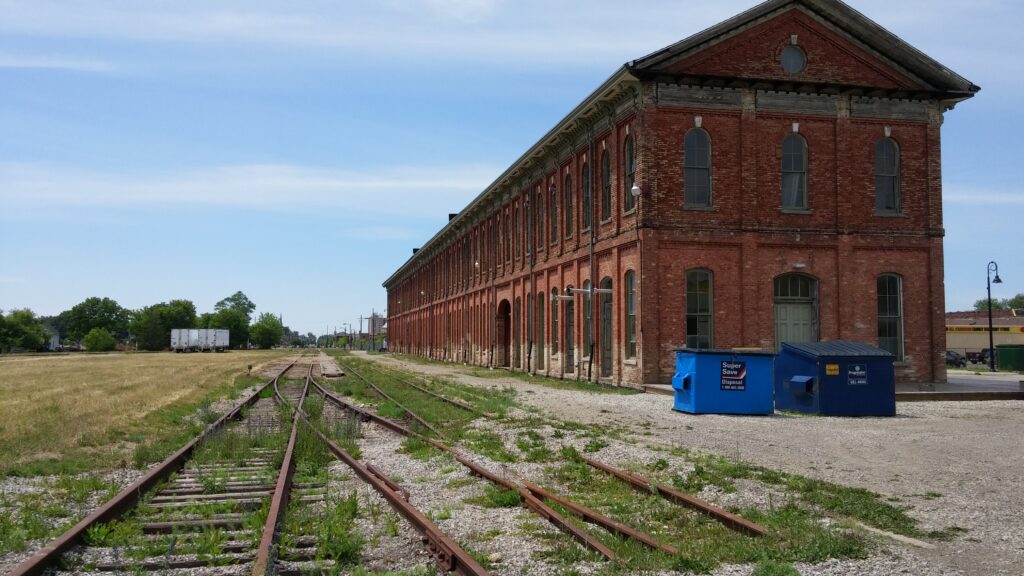
The Iron Bridge Brown IPA & Wright House Red Ale, Furnace Room Brewery, Georgetown, Ontario
These two beers are a recent discovery, and unfortunately I have been unable to sample them before publishing this post. Furnace Room Brewery opened their current location in 2018. It is located just south of the Canadian National Railway’s Halton Subdivision, and across the parking lot from the Georgetown VIA station. Both the rails and station got their start with the Grand Trunk Railway, who became established in the area with their acquisition of the Toronto and Guelph Railway. It became one of numerous stops along the GTR’s mainline across southwestern Ontario. The Georgetown Station was built in 1856 and was upgraded in 1904 to how it appears today. VIA Rail passenger trains operating between Sarnia and Toronto via Kitchener service passengers at the station today, while GO trains using the Kitchener Line arrive and depart at the Georgetown GO station across the tracks. Many long and heavy CNR freight trains rumble past enroute to destinations across Ontario.
Iron Bridge Brown IPA is a seasonal beer that is described as “strong and steady”, much like the bridge that inspired its name. The bridge in question is located at the east edge of town just over a couple of kilometers from the brewery and station. It was built to carry the rails of the Grand Trunk Railway over the Credit River. Despite being upgraded to support heavier and longer trains, it still stands in its original location today.
Wright House Red Ale is named after the former railway hotel that stood to the south of the GTR station. While officially called The Station House, it was often referred to as ‘Wright House” due to its ownership by Harry Wright. For many years it served as a popular watering hole for local residents as well as train travellers looking for a drink and a place to stay. I can remember seeing the distinct red-coloured structure from the view of a VIA Rail coach during my travels through the area. Despite standing for many years, the structure was completely demolished and gone when I last visited the site in September 2021,
I have enjoyed the Furnace Room products I’ve purchased from the LCBO. My last visit to the area was too short to stop for beer, but I hope to be back soon to sample the above listed railway themed beers.
For more information about the beer at Furnace Room Brewery please click here
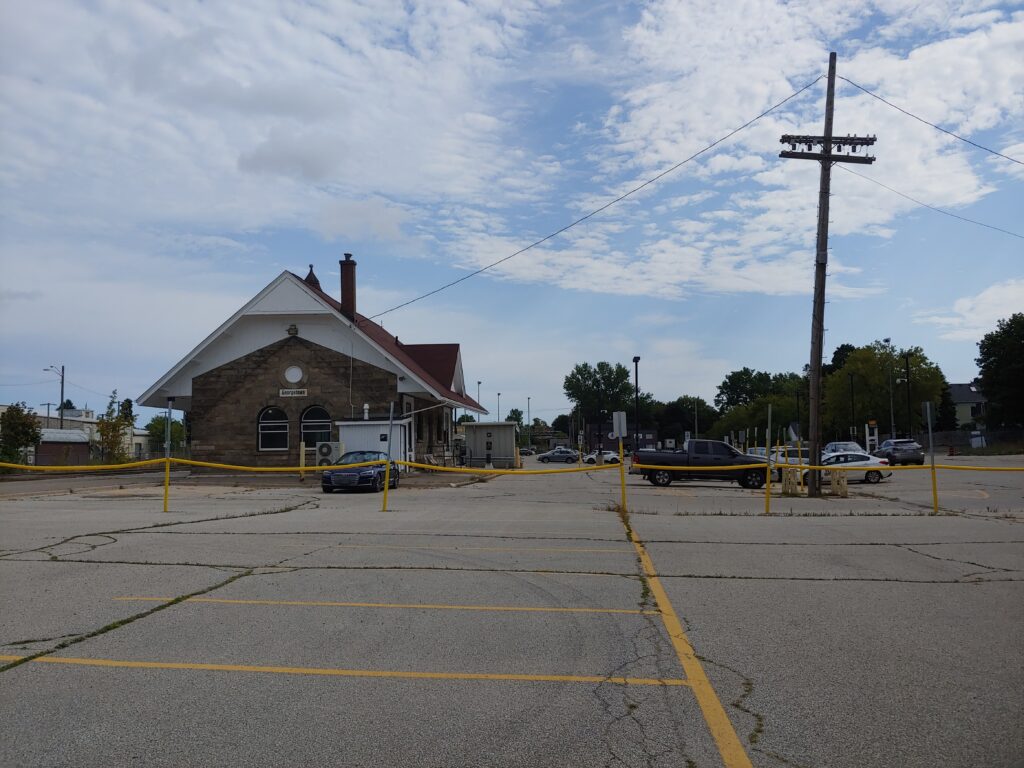
Witch’s Hat Black IPA, Second Wedge Brewing, Uxbridge, ON.
The final entry in this post is Witch’s Hat Black IPA. This beer is made by Second Wedge Brewing in Uxbridge. The brewery is located just across the tracks from Uxbridge’s distinct witches hat style station, which the beer is named for.
The witch’s hat station is the second to stand in Uxbridge. It was built in 1904 as a more elaborate replacement to the original structure, built by the Toronto & Nipissing Railway in 1871. The T&N was built as a narrow gauge resource railway designed to move commodities to the Gooderham & Worts Distillery in Toronto, known today as the Distillery District. As its name suggests, the intention of the line was to eventually extend up into rural Northern Ontario. Construction continued northeast from Uxbridge in 1871-72 through Sunderland, Cannington, and Woodville before reaching what became the end of the line at Coboconk. Uxbridge became a busy railway hub after later acquisition of the rails by the Midland, Grand Trunk, and Canadian National Railways. It served as an approximate halfway point for passenger trains between Toronto and Lindsay. It also saw numerous freight trains, including stone trains running along the T&N between Kirkfield and Toronto.
CNR passenger service to Uxbridge station terminated in 1962, with freight service continuing for another three decades. Mixed and regular freight service along the northern portion of the T&N to Coboconk ended in 1955 and 1966 respectively. Woodville, Cannington, and Sunderland received freight service as needed until 1987 when the rails were abandoned between Woodville and Blackwater Junction, just north of Uxbridge.
Currently, the York Durham Heritage Railway operates out of the station with many preserved passenger and freight cars stored on site. Their tourist train operates between Uxbridge and Stouffville, with occasional excursions to Unionville, the site of a preserved original T&N station. GO trains utilize the T&N route from Stouffville to Union Station via Scarboro Junction as part of the “Stouffville Line”
Witch’s Hat Black IPA has an opaque dark hue with a foamy head. At 6.5% ABV and 65 IBU, it’s definitely a heavier brew for a cooler day. A drawing of the witch’s hat station appears on the can (albeit with a pointer hat!). This beer was not available during my list trip to the brewery, but I did get some great photos of the station the beer is named after. Both the brewery and the YDHR are highly recommended.
For more information about Second Wedge Brewing please click here
For more information about the York Durham Heritage Railway please click here
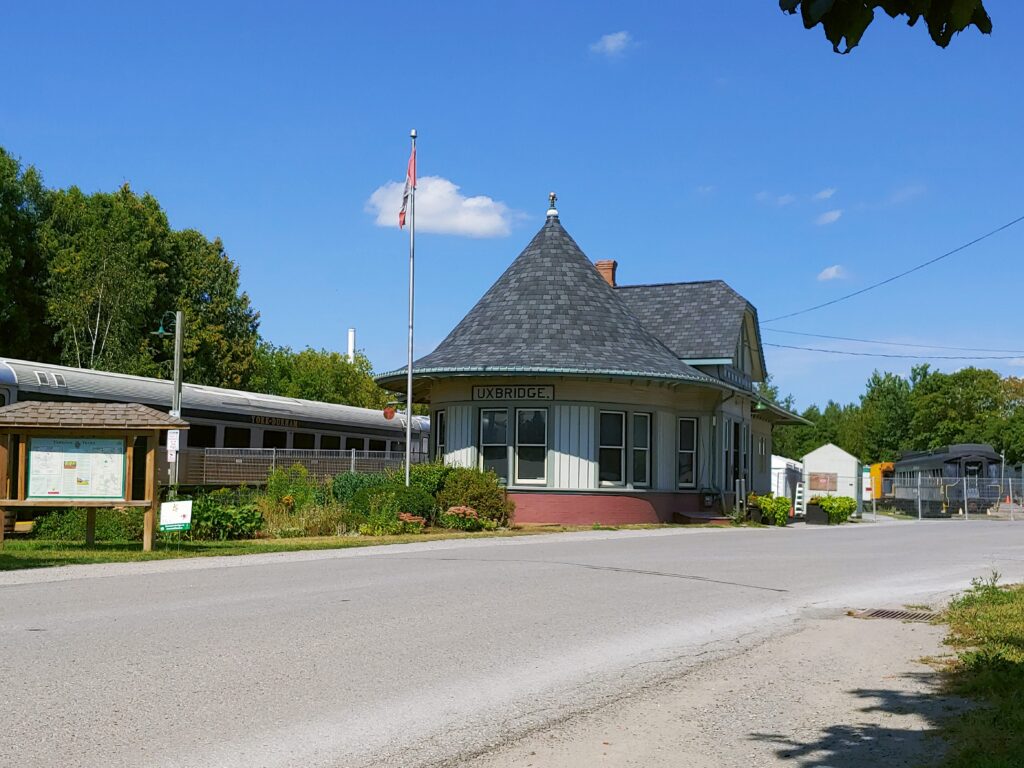
Author’s Note
I hope you have enjoyed this research blog series, and have learned about the many connections between Ontario railways and craft beer. I hope this has also helped shine a light on some awesome local businesses present in our communities.
I have received suggestions for various readers and fellow researchers for examples not included in this project. As a result, I will be creating a “bonus” part five that outlines these examples. I will also feature examples I came across that while interesting, did not quite fit into the various criteria of this series. Stay tuned for this post sometime closer to Christmas.
Do you know of an example I missed? If so, I’d love to hear about it! Please email all suggestions to danielallen.trombone@gmail.com.
Historical Sources:
Arculus, P. (2018). Nip ‘n Tuck: A History of the Whitby, Port Perry, and Lindsay Railway. Port Perry Print & Digital Services
Brown, R. (1998). Ghost Railways of Ontario. Polar Bear Press.
Caps Off Brewing Company. (2021). About Us. Retrieved on November 28th from https://capsoffbrewing.com/about-us/
Clarke, R. (2007). Narrow Gauge Through The Bush: Ontario’s Toronto Grey & Bruce and Toronto & Nipissing Railway. Self published.
De Fort-Menares, A.M. (n.d.). Durability and Parsimony: Railway Station Architecture in Ontario, 1853-1914. SSAS Bulletin SEAC, 21(1), 25-31. https://dalspace.library.dal.ca/bitstream/handle/10222/71207/vol21_1_25_31.pdf?sequence=1&isAllowed=y
Esquesing Historical Society. (2017). Grand Trunk Railway 1855. Retrieved on November 28th, 2021 from http://esquesinghistoricalsociety.com/2017/03/11/grand-trunk-railway-1855/
Esquesing Historical Society. (2017). Guelph-Toronto Road/Railroad. Retrieved on November 28th, 2021 from http://esquesinghistoricalsociety.com/2017/03/05/guelph-toronto-road-railroad/
Furnace Room Brewery. (2021). Beer. Retrieved on November 28th, 2021 from https://furnace-room-brewery.myshopify.com/collections/beer
Hansen, K. (1997). Last Trains From Lindsay. Sandy Flats Publications.
Heels, C.H. (1980). Railroad Recollections. Museum Restoration Service.
Here’s Everything We Know About This New Brewery Coming to Halton Hills. (2018). InHalton. https://www.insauga.com/heres-everything-we-know-about-this-new-brewery-coming-to-halton-hills/
J.E. Seagram’s Distillery Administration and Maintenance Buildings. (n.d.). Canada’s Historic Places. https://www.historicplaces.ca/en/rep-reg/place-lieu.aspx?id=11652&pid=0
Labatt Brewery, Waterloo, Ontario. (n.d.). Waterloo Public Library. https://images.ourontario.ca/waterloo/details.asp?ID=30858
Manitoulin Brewing Company. (2020). Manitoulin Brewing Co. Retrieved on November 28th, 2021 from https://www.manitoulinbrewing.co/
Martel, D. (2013, June 21). Georgetown Homecoming: Memories of The Station Hotel. Independent Free Press. https://www.theifp.ca/news-story/5369912-georgetown-homecoming-memories-of-the-station-hotel/
Mills, J. (1977). Traction on The Grand: The Story of Electric Railways along Ontario’s Grand River Valley. Railfare Enterprises Limited.
Pie Eyed Monk – Lindsay Brewing Company. (n.d.) Lindsay Brewing Company. Retrieved on November 28th, 2021 from https://www.pieeyedmonkbrewery.com/lindsay-brewing-company
Port Stanley Terminal Railway. (n.d.). A Brief History of The L&PS and PSTR. Retrieved
November 21st, 2021 from https://www.pstr.on.ca/history.htm
Second Wedge Brewing Company. (2021). Home. Retrieved on November 28th, 2021 from https://thesecondwedge.ca/
Stockyards Beverage Company. (n.d.). Stockyards Beverage Company. Retrieved on November 28th, 2021 from https://www.stockyardsbeverage.co/
Thomson, B. (n.d.). Railpictures.ca. Retrieved November 21, 2021 from http://www.railpictures.ca/upload/canadian-pacific-sw1200rs-8161-switches-the-seagrams-distillery-plant-in-waterloo-the-locomotive-is-coming-back-onto-the-street-running-portion-of-the-grand-river-railway-line-on-caroline-street-a?fbclid=IwAR3o30yBxnxwCekkypQbjRwQOYpuexYS4ZRxxlHgo9hskfuYapcKYmxGgD8
Untappd. (2021). Untappd: Devils Edge Brewery (Version 4.0.13) [Mobile app]. Google Play Store. https://untappd.com/w/devil-s-edge-brewery/412810
VIA Rail/Canadian National Railways Station, Georgetown, Ontario. (n.d.). Canada’s Historic Places. https://www.historicplaces.ca/en/rep-reg/place-lieu.aspx?id=4622
Wilkins, T. (1992). Haliburton By Rail and The IB&O. Self-published.
Wilson, D. (2003). Algoma Eastern Railway. Old Time Trains. http://www.trainweb.org/oldtimetrains/sudbury/Algoma_Eastern.htm
Wilson, D.M. (1984). The Ontario & Quebec Railway. The Ontario & Quebec Railway, Donald M. Wilson
York Durham Heritage Railway. (n.d.). Home. Retrieved on November 28th, 2021 from https://ydhr.ca/


